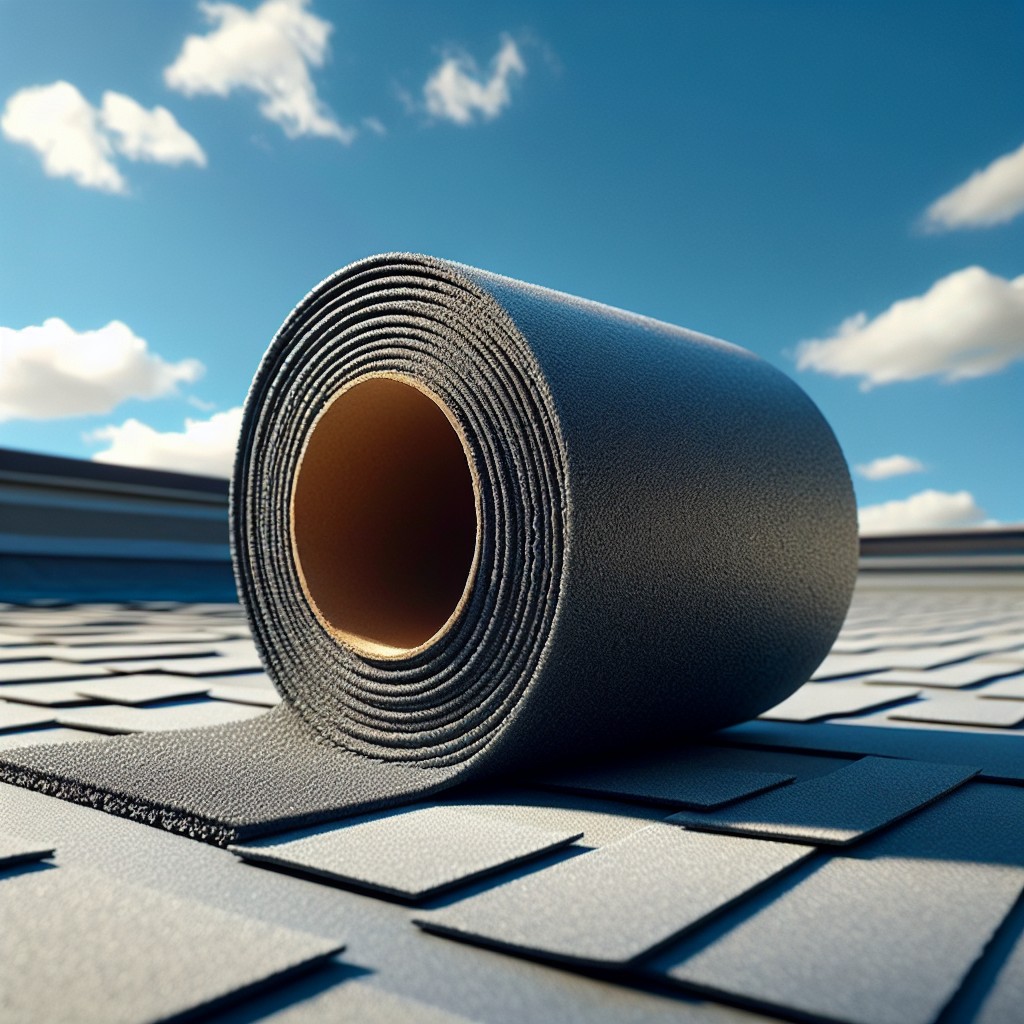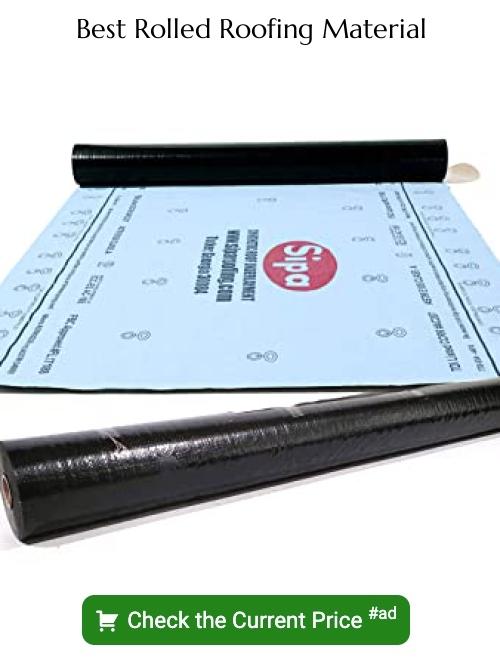Last updated on
Exploring rolled composition roofing is a must because its durability, cost-effectiveness, and ease of installation make it an ideal option for homeowners and contractors alike.
Key takeaways:
- Rolled roofing is lightweight, economical, and easy to install.
- Materials include asphalt, fiberglass or organic felt, and mineral granules.
- Installation process involves preparing the roof deck, measuring, and overlapping layers.
- Regular inspections, drainage, and roof coating are important for maintenance.
- Lifespan ranges from 5 to 15 years, with factors like installation quality and climate affecting durability.
What Is Rolled Roofing?

Rolled roofing, also known as MSR (mineral-surfaced roll roofing), is a lightweight, economical roofing material primarily used on low-slope roofs. Manufactured in large rolls that are typically 36 inches wide, it is composed of a layer of asphalt and either fiberglass or organic felt for a base. The top surface is covered with mineral granules that protect the asphalt from the sun’s UV rays.
Due to its design, this type of roofing is quick to install, providing a continuous, sealed surface that offers basic protection against the elements. Typically chosen for utilitarian buildings like sheds, shops, and barns, rolled roofing can be a cost-effective solution for residential applications with appropriately low roof pitches. It’s essential to note that while rolled roofing offers convenience and affordability, its aesthetic appeal and durability are generally considered to be less than those of traditional shingles.
Materials and Composition of Rolled Roofing

Rolled roofing, commonly crafted from the same materials as asphalt shingles, is a cost-effective and straightforward solution for covering low slope and flat roofs. Typically, it consists of a base mat made from fiberglass or organic materials, which is then saturated with asphalt for waterproofing. The outer surface is coated with mineral granules that provide UV protection and add to the product’s durability.
Key points about the composition of rolled roofing:
- Base Material: Organic mats, once the norm, have increasingly been replaced by more durable and lighter fiberglass options.
- Asphalt Coating: Ensures that the product is waterproof, a vital characteristic for effective roofing material.
- Top Layer: Fine mineral granules shield the roof from sun damage while giving it a finished look.
- Width and Length: Rolls are typically 36 inches wide and come in various lengths, up to 36 feet, making them suitable for a swift and seamless installation process.
- Colors and Textures: A range of colors and textures are available to match different aesthetic preferences and to blend with traditional shingle roofing when needed.
Installation Process of Roll Roofing
Ensure the roof deck is clean, dry, and free from protrusions. Repair any damages to the substrate before beginning the roll roofing installation to create a solid base.
Measure the roof to determine how much material you will need, allowing for an overlap of at least two inches on the edges. Cut the roll roofing to size according to your measurements.
Begin at the bottom edge of the roof and roll out the first course horizontally, parallel to the eaves. Secure the edge by nailing along the bottom, spacing nails 6-8 inches apart.
Apply roofing cement beneath the upper edge of the roll, then press it firmly into place. This seals the material and prevents water ingress.
Overlap subsequent layers over the first by at least two inches, nailing in the same manner, to ensure a watertight seal between courses.
Install flashing around roof features like vents, chimneys, and along the hips and ridges to ensure water is directed away from these vulnerable areas.
Finish the installation by trimming excess material at the roof edges and sealing the edges with roofing cement to ensure a neat appearance and additional protection against the elements.
Maintenance of Rolled Roofing
Regular inspections are crucial, ideally twice a year and after major weather events, to identify potential issues early on. Debris should be cleared from the roof surface to prevent damage and accumulation of moisture. Seams and edges require attentive examination to ensure that they remain sealed and intact. Any punctures, tears, or areas that are coming up must be repaired promptly to prevent water infiltration.
Drainage is also a key component of maintenance. To prevent ponding water that can lead to accelerated aging of the roofing material, ensure that gutters and downspouts are free of clogs.
Consider the application of a roof coating, which can extend the life of the roof by providing additional UV protection and water resistance. However, before applying any coatings or performing repairs, it is essential to clean the roof surface thoroughly.
Lastly, it is important to trim overhanging tree branches that may pose a risk to the roofing material. Falling limbs and accumulated leaves can be detrimental to the roof’s integrity, and keeping them at bay will aid in maintaining the roof’s condition.
Life Expectancy of Rolled Roofing
The longevity of rolled roofing typically spans between 5 to 15 years, with variations depending on several factors:
- Installation quality: Precise adherence to guidelines during installation can significantly extend the service life.
- Material composition: Higher-quality materials often lead to longer lifespans.
- Climate: Regions with extreme weather conditions may cause faster deterioration.
- Roof slope: Higher slope roofs can shed water more effectively, contributing to longer roof life.
- Maintenance: Regular inspections and prompt repairs can prevent minor issues from escalating, thereby preserving the roofing material.
- Sun exposure: Constant, intense sun can accelerate the aging process of roofing materials.
Understanding these elements helps homeowners manage expectations and plan for maintenance and replacement.
Benefits and Drawbacks of Rolled Roofing
Rolled roofing presents a practical and cost-effective solution for many property owners. Here are some primary benefits:
- Cost-Efficiency: It usually costs significantly less than traditional shingles, which can be a considerable advantage for homeowners on a budget.
- Ease of Installation: With fewer tools and less labor required for installation, it’s a suitable choice for DIY enthusiasts and quick turnaround projects.
- Flexibility: This type of roofing can be an excellent choice for low-slope or flat roofs, where other materials may not perform as well.
However, there are also some limitations to consider:
- Aesthetic Appeal: Rolled roofing tends to have fewer style and color options, which might not suit those looking for a more customized appearance.
- Durability: While it provides a protective layer, it is generally not as durable as other roofing types and may require more frequent maintenance or replacement.
- Resale Value: Homes with this type of roofing may not have the same resale value as those with more traditional materials, such as architectural shingles.
Understanding these pros and cons helps homeowners make informed decisions tailored to their specific needs and the demands of their roofing projects.
Rolled Roofing Vs. Shingles: Which Is Better?
Choosing between rolled roofing and shingles depends on specific project needs. Rolled roofing, due to its large coverage per roll, is a quick-install solution ideal for low-slope roofs; it’s a cost-effective option for sheds and workshops where aesthetics are less of a priority.
In contrast, shingles offer more visual appeal and color variety, making them well-suited for residential homes. They also provide better longevity and wind resistance, which is important in areas with harsh weather conditions. However, shingles are usually more labor-intensive to install and can come at a higher cost.
Homeowners should consider the roof’s slope, desired durability, and budget when making a decision.
What Is Self-Adhesive Roll Roofing?
Self-adhesive roll roofing simplifies the installation process by eliminating the need for fasteners or adhesives. Here’s how it works:
- Backing Peel: The material comes with a protective backing that, once peeled off, exposes the adhesive layer.
- Direct Application: Without the use of torches or hot asphalt, the product adheres directly to the roof deck.
- Sealing Method: Overlapping seams create a water-resistant bond due to the pressure-sensitive adhesive.
- Ideal Conditions: Optimal for low-slope or nearly flat roofs, as it provides a continuous sealed surface.
- Versatility: Can be used for new roofing, re-roofing, or as a patching material.
- Temperature Sensitivity: Best installed in warm weather to ensure proper adhesion.
Understanding self-adhesive roofing offers a convenient and user-friendly option for roofing projects.
Environmental Considerations and Sustainability of Rolled Roofing
When assessing the eco-friendliness of rolled roofing, several factors merit consideration:
Material composition: Rolled roofing often contains asphalt, a by-product of petroleum refining, and fiberglass, which is not renewable. Efforts to incorporate more recycled materials are underway to minimize environmental impact.
Energy efficiency: The color and material of rolled roofing can influence building temperature. Lighter colors reflect sunlight, reducing cooling costs in warmer climates. Conversely, darker materials may increase heat absorption.
Lifespan: While not as long-lasting as some alternative roofing materials, rolled roofing can last from 5 to 15 years. A shorter lifespan necessitates more frequent replacement, creating additional material and waste management concerns.
Recyclability: Disposal presents challenges because asphalt-based materials are not readily recyclable. Innovations in recyclability are crucial to reducing the ecological footprint of roofing waste.
Manufacturing process: The production of rolled roofing materials is energy-intensive, contributing to its environmental impact. Advances in manufacturing aim to reduce energy consumption.
By prioritizing sustainability, researching eco-friendly options, and proper end-of-life disposal, homeowners can reduce the environmental impact of their rolled roofing choices.
FAQ
Is rolled roofing better than shingles?
While rolled roofing is a more economical option suitable for low-slope or flat roofs, shingles offer superior durability, aesthetic value, and longevity, but at a steeper price.
What is the lifespan of rolled roofing?
The lifespan of rolled roofing typically ranges between five to 15 years, often tending towards less than 10 years.
When should rolled roofing be used?
Rolled roofing should be used on low-sloped roofs, particularly those with a pitch that declines up to 1 inch vertically for every 12 inches horizontally, employing the concealed nail method of fastening.
What are the primary materials used in manufacturing rolled roofing?
The primary materials used in manufacturing rolled roofing are bitumen, asphalt-saturated organic felts, glass fiber mats, or polyester mats for reinforcement.
How does temperature influence the installation process of rolled roofing?
Temperature significantly impacts the installation process of rolled roofing as it affects the flexibility of the material, with cold weather making it more brittle and difficult to unroll without cracking, and hot weather causing it to be overly sticky and challenging to handle.
What maintenance practices are crucial for maximizing the lifespan of rolled roofing?
Regular inspections, prompt repairs of any damages, keeping the roof free from debris, and ensuring proper ventilation are crucial maintenance practices for maximizing the lifespan of rolled roofing.





